Physical Address
304 North Cardinal St.
Dorchester Center, MA 02124
Physical Address
304 North Cardinal St.
Dorchester Center, MA 02124

Never let poor dog camping etiquette ruin your outdoor adventure—these essential rules prevent disasters that could get you banned from campgrounds.
You’re probably excited about bringing your dog on your next camping adventure, but poor pet etiquette can quickly turn your dream trip into a nightmare for everyone around you. From unrestrained dogs terrorizing other campers to incessant barking at 2 AM, the mistakes you make with your furry companion can get you kicked out of campgrounds or worse. Before you pack that leash and hit the trail, there are nine critical rules you absolutely must follow to avoid becoming that camper.
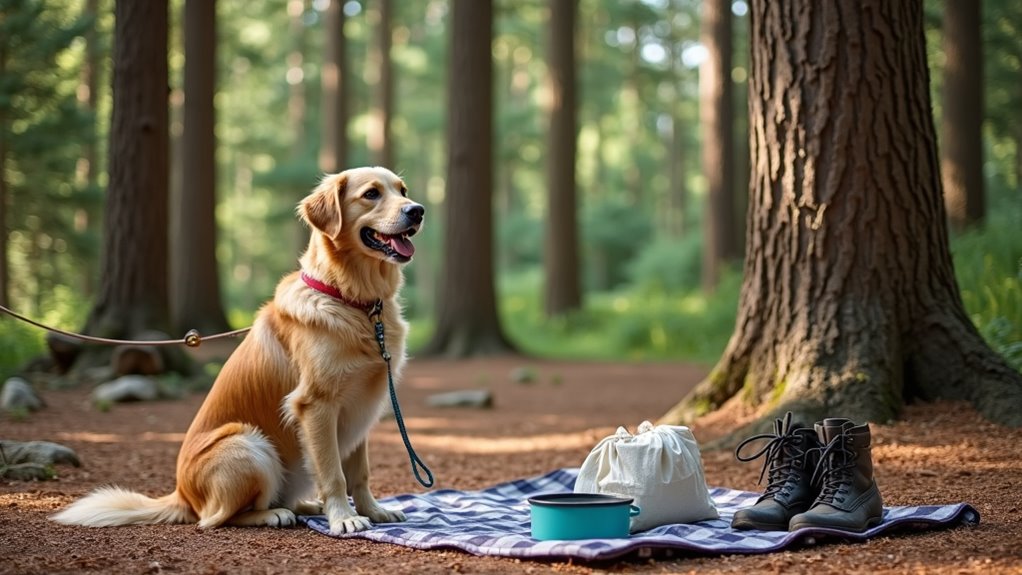
Before you pack your tent and load up the car, you’ll need to verify that your chosen campground actually welcomes four-legged guests. Not all campgrounds allow pets, and those that do often have strict regulations you must follow.
Start by checking the campground’s official website or calling directly to confirm their pet policy. Ask about leash requirements, designated pet areas, and any breed restrictions. Some places charge additional pet fees, while others limit the number of animals per campsite.
Always call ahead to confirm pet policies, fees, and restrictions before booking your campsite to avoid unwelcome surprises.
Pay attention to specific rules about where pets can walk, sleep, and relieve themselves. Many campgrounds prohibit pets on certain trails or near water sources.
Document these requirements before your trip to avoid disappointing surprises at check-in. Pet-friendly caravan parks often provide detailed guidelines about proper etiquette to ensure all guests have an enjoyable experience.
Even if your dog is perfectly trained at home, maintaining leash control becomes essential in the unpredictable camping environment. Wild animals, unfamiliar scents, and other campers can trigger unexpected reactions from even the most obedient pets.
A leash protects your dog from dangerous wildlife encounters and prevents them from disturbing other campers’ peaceful experience. It also keeps them away from campsites with food that could make them sick or cause conflicts with neighboring families.
Most campgrounds require leashes anyway, but beyond compliance, it’s about respect. Other campers shouldn’t have to worry about an unleashed dog approaching their children or contaminating their cooking areas.
Keep that leash short enough for control but long enough for your dog’s comfort while exploring. Whether you’re tent camping or traveling in an RV, responsible pet ownership means minimizing your environmental impact while enjoying eco-friendly living on the road.
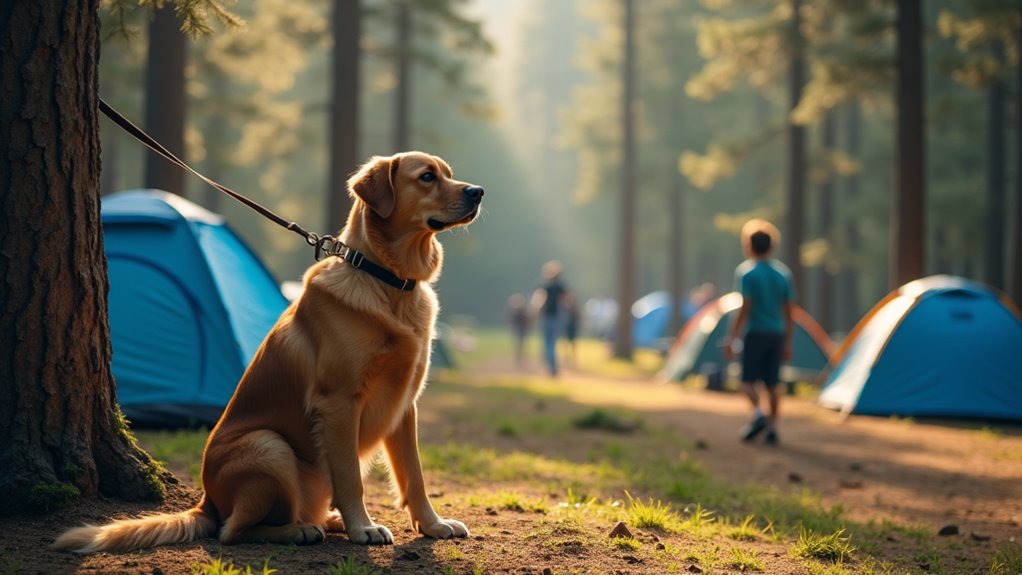
Your dog’s presence shouldn’t infringe on other campers’ ability to enjoy their outdoor getaway. Being mindful of boundaries creates a harmonious camping environment for everyone.
Respecting campground boundaries and fellow outdoor enthusiasts ensures everyone can peacefully enjoy their wilderness experience together.
Here’s how you can respect fellow campers:
If you’re planning to explore more challenging terrain with your pet, remember that some activities like glacier climbing require specialized skills and may not be suitable for bringing dogs along.
While most responsible pet owners understand basic cleanup duties at home, camping environments demand even greater vigilance since you’re sharing natural spaces with wildlife and fellow outdoor enthusiasts. Always carry extra waste bags and dispose of them in designated receptacles or pack them out completely. Don’t bury pet waste or leave it behind rocks—it contaminates water sources and attracts unwanted animals to campsites.
Clean up food spills, scattered kibble, and water bowl messes immediately. These remnants invite raccoons, bears, and other wildlife into camping areas, creating dangerous situations for everyone. Bring biodegradable soap for washing food bowls away from water sources.
Your quick cleanup efforts protect the environment while showing respect for other campers who’ll use the space after you leave. Remember that maintaining a clean campsite is one of the key elements that makes family camping such a rewarding and safe adventure for everyone involved.
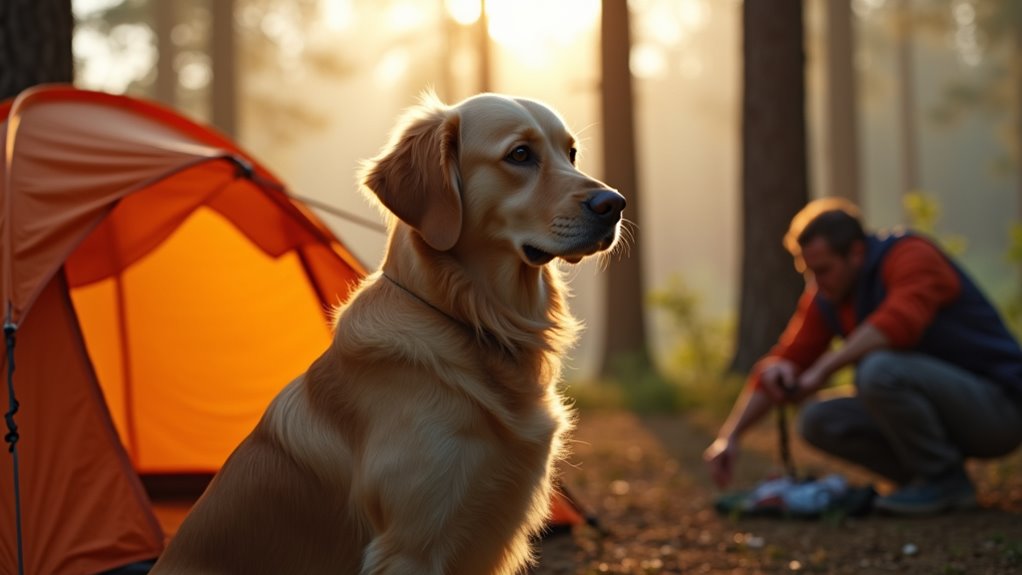
Since camping offers a peaceful escape from urban chaos, excessive pet noise can quickly ruin the experience for everyone around you. Your dog’s barking echoes through campsites and disturbs fellow campers trying to enjoy nature’s tranquility.
Here’s how to keep noise levels manageable:
Plus, pack winter camping foods that won’t require excessive preparation noise during cold-weather adventures when your pet might already be on edge from temperature changes.
Food storage becomes critical when camping with pets, as improper handling attracts dangerous wildlife and creates health hazards for both you and your furry companion. Store all pet food, treats, and human food in airtight containers or bear-proof canisters. Don’t leave food bowls outside unattended—clean them immediately after meals and store them securely.
Keep pet supplies like toys, leashes, and waste bags organized in sealed containers to prevent wildlife encounters and maintain campsite cleanliness.
Never feed your pet scraps around the campsite, as food odors linger and draw unwanted visitors. Pack extra supplies in case of emergencies, but store everything properly. Following established safe food storage**** guidelines helps ensure that perishable items remain fresh and contamination-free throughout your camping trip. Your diligence in food storage protects both your pet’s safety and preserves the natural environment for other campers and wildlife.
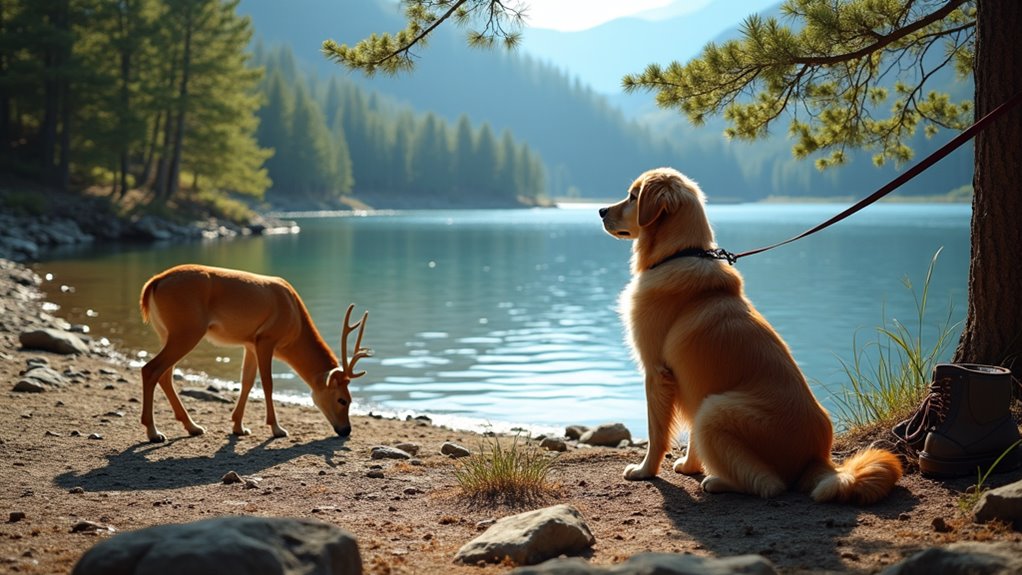
Beyond securing your supplies, maintaining constant awareness of your pet’s surroundings becomes your next priority in the wilderness. Wild animals pose serious threats to curious pets, while water sources can harbor dangerous bacteria or swift currents that’ll endanger your companion.
Keep these supervision essentials in mind:
Constant vigilance and proactive supervision form the foundation of keeping your pet safe in unpredictable wilderness environments.
Your vigilance prevents dangerous encounters. Whether you’re camping from your boat or staying overnight at remote locations, having the right camping equipment ensures you can properly secure and monitor your pet throughout your adventure.
While campfires create memorable moments during outdoor adventures, they present unique hazards when pets join the experience. You’ll need to establish a safe perimeter around your fire pit using a leash or portable barrier to prevent your pet from getting too close. Never leave your furry friend unsupervised near an active fire, as curious animals can easily knock over equipment or step on hot embers.
Keep water nearby for emergencies and watch for signs your pet’s overheating from the fire’s warmth. Store firewood and kindling away from where your pet plays to avoid splinters or accidents.
When extinguishing the fire, ensure your pet stays back until ashes cool completely. Hot coals remain dangerous long after flames disappear. Consider connecting with local camping clubs to learn from experienced pet owners who can share additional safety strategies for campfire management with animals.
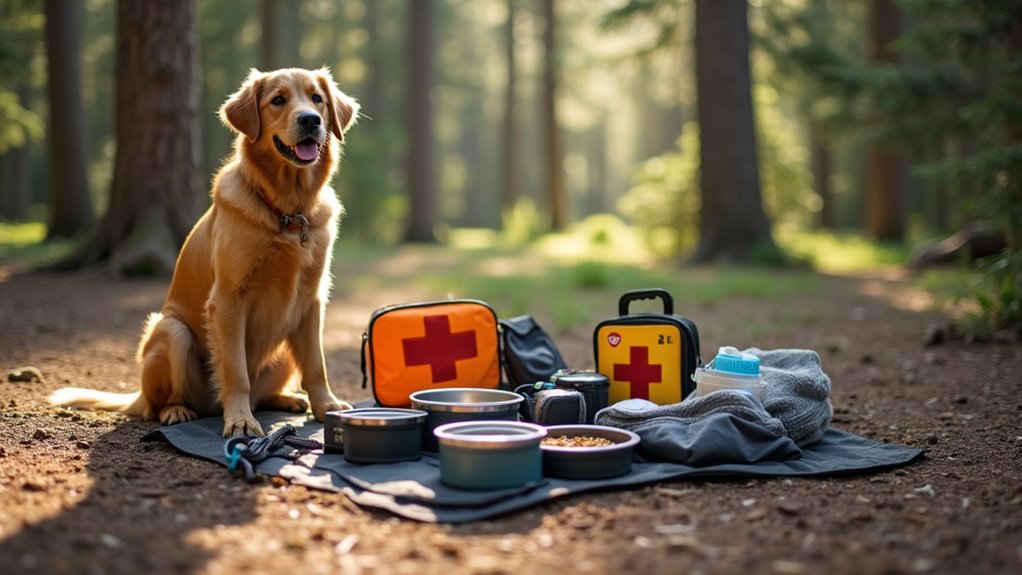
Before you hit the trail, create a thorough packing checklist that covers your pet’s basic needs and potential emergencies. Don’t assume you’ll find what you need at remote campgrounds.
Pack these camping essentials for your furry companion:
Just like any summer camping adventure, proper preparation with the right gear will ensure both you and your pet have a safe and enjoyable experience.
You’ll thank yourself when you’re prepared for unexpected situations that could otherwise ruin your camping adventure.
Packing smart sets you up for success, but your responsibility extends beyond keeping your pet safe—you must also protect the wilderness areas you’re visiting.
Always clean up after your dog immediately, carrying waste bags and disposing of them properly in designated trash receptacles. Don’t bury pet waste, as it contaminates water sources and disrupts local ecosystems.
Pet waste left behind pollutes waterways and harms fragile wilderness ecosystems—always pack it out responsibly.
Keep your dog on established trails to prevent erosion and vegetation damage. Never let them chase wildlife or disturb nesting areas.
Pack out all pet food remnants and treats—these attract unwanted animals to campsites.
Control barking to preserve the natural soundscape for wildlife and other campers.
Choose durable surfaces for pet activities when possible, and avoid camping in sensitive areas like meadows or near water sources where your pet’s presence creates lasting impact.
If you’re planning to camp alone with your pet, research solo-friendly campsites that accommodate both you and your furry companion while maintaining proper environmental standards.
Think of camping etiquette with your pet as weaving a tapestry of respect—each thread represents consideration for nature, fellow campers, and your furry companion. When you follow these guidelines, you’re creating memorable adventures while preserving the outdoors for everyone. Your responsible choices today ensure campgrounds remain welcoming to pets tomorrow. So pack that leash, grab the waste bags, and head out knowing you’ll leave only pawprints and take only wonderful memories.